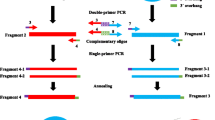Abstract
Use of the polymerase chain reaction (PCR) provides a convenient means of generating DNA fragments for insertion into plasmids. Large quantities of the desired insert, bounded by convenient restriction sites, may be synthesized. The primers are chosen to span a known region of interest, and extended at their 5′-ends to include the desired restriction sites. Amplification of the target sequence is followed by precipitation of the product with ammonium acetate and ethanol to remove the primers. A small amount of product is analyzed by gel electrophoresis to ensure correct amplification, the remainder is digested with the appropriate restriction enzyme(s). Restricted insert DNA is added to similarly restricted plasmid DNA in several ratios and incubated with DNA ligase to recircularize. Ligation products are used to transform competent bacteria. Clones containing inserts are identified by restriction digestion of plasmid minipreps from bacterial colonies.
Similar content being viewed by others
References
Estus, S., Zaks, W. J., Freeman, R. S., Gruda, M., Bravo, R., and Johnson, E. M. (1994) Altered gene expression in neurons during programmed cell death: identification of c-jun as necessary for neuronal apoptosis.J. Cell. Biol. 127, 1717–1727.
Delidow, B. C., Lynch, J. P., Peluso, J. J., and White, B. A. (1993)Polymerase Chain Reaction: Basic Protocols, inMethods in Molecular Biology, Vol. 15: PCR Protocols (White, B. A., ed.), Humana, Totowa, NJ, pp. 1–29.
White, B. A. (ed.) (1993)Methods in Molecular Biology, Vol. 15: PCR Protocols. Humana, Totowa, NJ.
Mead, D. A., Pey, N. K., Herrnstadt, C., Marcil, R. A., and Smith, L. M. (1991) A universal method for the direct cloning of PCR amplified nucleic acid.Biotechnol. 9, 657–663.
Hengen, P. N. (1995) Methods and reagents. Cloning PCR products using T-vectors.Trends Biochem. Sci. 20, 85,86.
Clark, J. M. (1988) Novel non-templated nucleotide addition reactions catalyzed by procaryotic and eucaryotic DNA polymerases.Nucleic Acids Res. 16, 9677–9686.
Ausubel, F. M., Brent, R., Kingston, R. E., Moore, D. D., Smith, J. A., Seidman, J. G., and Struhl, K. (1992)Current Protocols in Molecular Biology. Wiley Interscience, New York.
Sambrook, J., Fritsch, E. F., and Maniatis T. (1989)Molecular Cloning. A Laboratory Manual. Cold Spring Harbor Laboratory Press, Cold Spring Harbor, NY.
Kaufman, D. L. and Evans, G. A. (1990) Restriction endonuclease cleavage at the termini of PCR products.BioTechniques 9, 304–306.
Crouse, J. and Amorese, D. (1986) Double digestions of the multiple cloning site.Focus 8, 9.
New England Biolabs (1995)Cleavage Close to the Ends of DNA Fragments, Catalog, Beverly, MA, pp. 208, 209.
Eckert, K. A. and Kunkel, T. A. (1990) High fidelity DNA synthesis by the Thermus aquaticus DNA polymerase.Nucleic Acids Res. 18, 3739–3744.
Eckert, K. A. and Kunkel, T. A. (1991) DNA polymerase fidelity and the polymerase chain reaction.PCR Methods Appl. 1, 17–24.
Lundberg, K. S., Shoemaker, D. D., Adams, M. W., Short, J. M., Sorge, J. A., and Mathur, E. J. (1991) High-fidelity amplification using a thermostable DNA polymerase isolated fromPyrococcus furiosus.Gene 108, 1–6.
Mattila, P., Korpela, J., Tenkanen, T., and Pitkänen, K. (1991) Fidelity of DNA synthesis by the Thermococcus litoralis DNA polymerase—an extremely heat stable enzyme with proofreading activity.Nucleic Acids Res. 19, 4967–4973.
deNoronha, C. M. and Mullins, J. I. (1992) Amplimers with 3′-terminal phosphorothioate linkages resist degradation by vent polymerase and reduce Taq polymerase mispriming.PCR Methods Appl. 2, 131–136.
Author information
Authors and Affiliations
Corresponding author
Rights and permissions
About this article
Cite this article
Delidow, B.C. Molecular cloning of PCR fragments with cohesive ends. Mol Biotechnol 8, 53–60 (1997). https://doi.org/10.1007/BF02762339
Issue Date:
DOI: https://doi.org/10.1007/BF02762339




